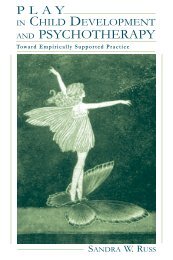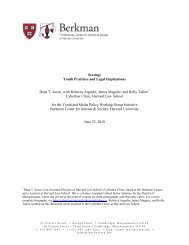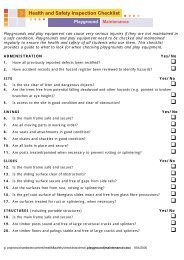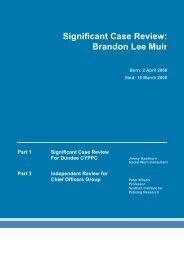Download PDF - Fair Play For Children
Download PDF - Fair Play For Children
Download PDF - Fair Play For Children
Create successful ePaper yourself
Turn your PDF publications into a flip-book with our unique Google optimized e-Paper software.
in residential areas. In many cases, they may help to improve safety on the journey to or from<br />
play areas.<br />
26.<br />
27.<br />
Research published in 1996 shows that the number of accidents involving children reduced<br />
by 67 per cent in 20mph zones incorporating traffic calming measures. On the basis of this<br />
information DfT issued best practice advice on the implementation of 20mph zones. However,<br />
many more local authorities have since introduced 20mph zones, and over wider areas, and<br />
so an up-to-date assessment is needed of the implementation process and effectiveness. We<br />
are commissioning a new assessment and will produce further best practice advice to support<br />
those local authorities already implementing 20mph zones, and promote the benefits to those<br />
which have yet to do so.<br />
Transport for London is also proposing to trial later this year the enforcement of 20mph zones<br />
through the use of time over distance camera systems as an alternative to traffic calming<br />
measures.<br />
Home Zones<br />
28.<br />
29.<br />
30.<br />
31.<br />
32.<br />
Home Zones are residential areas where the streets are designed to be places for pedestrians<br />
and cyclists (including children), instead of simply corridors for motor traffic. The aim is to<br />
change the way that streets are used in order to improve the quality of life in residential streets.<br />
Introducing a Home Zone will allow scope for a range of social activities, such as stopping to<br />
chat and children’s play, to take place in street space formerly considered to be exclusively for<br />
vehicles.<br />
Modifications to the layout of the street should emphasise this change of use, so that motorists<br />
understand the need to share the street with other road users. This is achieved by creating an<br />
environment which encourages very low vehicular speeds. This natural traffic calming effect<br />
is realised through, for example, the placing of parking bays, street furniture, planting, and<br />
children’s play equipment etc to create indirect routes through the area, and shortened driver<br />
sightlines.<br />
Good and effective consultation with all sectors of the community, including young people, is<br />
important, and can help ensure that the design of individual Home Zones meets the needs of<br />
the local residents.<br />
Whilst primarily aimed at improving quality of life, Home Zones can in theory generate road<br />
safety benefits. However, as Home Zones were only introduced where the safety record was<br />
already good, the reduction in traffic flow and speeds resulting from their implementation<br />
would only be likely to realise minimal safety benefits at best. Where successfully implemented,<br />
Home Zones have led to stronger, more vibrant and diverse communities, fewer empty<br />
properties and reduced crime.<br />
In April 2001, the Prime Minister announced a £30m challenge fund to encourage the<br />
development of new Home Zone schemes in England. Many of the authorities identified<br />
additional funding from a range of sources resulting in a total budget of over £50m for the<br />
<strong>Fair</strong> <strong>Play</strong>: A consultation on the play strategy<br />
67




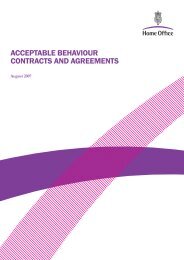
![The Childcare Act 2006 - Notes [Website] - Fair Play For Children](https://img.yumpu.com/50144819/1/184x260/the-childcare-act-2006-notes-website-fair-play-for-children.jpg?quality=85)




![Bouncy Castles [PDF] - Fair Play For Children](https://img.yumpu.com/45463572/1/184x260/bouncy-castles-pdf-fair-play-for-children.jpg?quality=85)

